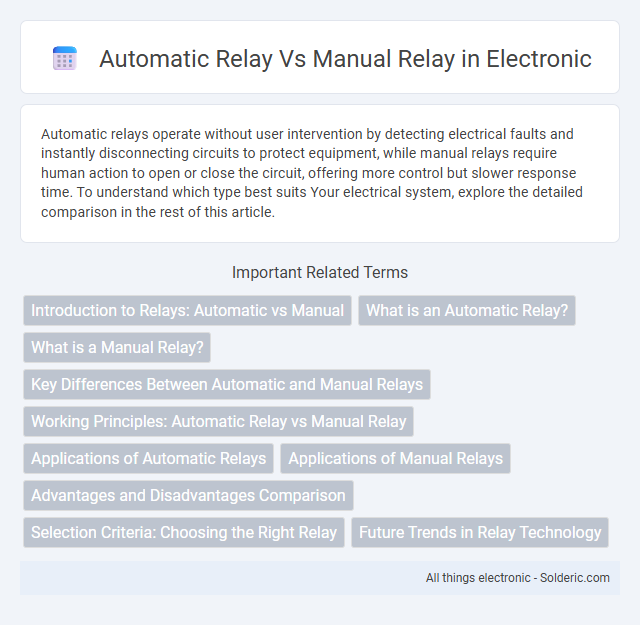Automatic relays operate without user intervention by detecting electrical faults and instantly disconnecting circuits to protect equipment, while manual relays require human action to open or close the circuit, offering more control but slower response time. To understand which type best suits Your electrical system, explore the detailed comparison in the rest of this article.
Comparison Table
| Feature | Automatic Relay | Manual Relay |
|---|---|---|
| Operation | Self-activates based on system conditions | Requires human intervention to operate |
| Speed | Instantaneous or rapid response | Slower response due to manual control |
| Reliability | Consistent and error-free operation | Prone to human error and delays |
| Use Case | Protection systems, automated switching | Backup or specific control scenarios |
| Cost | Higher initial investment | Lower initial cost |
| Maintenance | Requires regular testing and calibration | Minimal maintenance, simple checks |
| Example | Automatic circuit breakers, protective relays | Manual switchgear, hand-operated relays |
Introduction to Relays: Automatic vs Manual
Automatic relays operate by detecting electrical faults and switching circuits without human intervention, enhancing system protection and reducing downtime. Manual relays require a person to physically operate the switch, which can delay response time but allows greater control during maintenance or emergencies. Understanding how automatic and manual relays function helps you choose the best option for reliable and efficient electrical circuit management.
What is an Automatic Relay?
An automatic relay is an electrical switch that operates by detecting changes in voltage or current to control a circuit without human intervention. It enhances system reliability by instantly responding to faults or overloads to protect equipment and maintain continuous operation. Your electrical system benefits from automatic relays through improved safety and reduced downtime compared to manual relays.
What is a Manual Relay?
A manual relay is an electromechanical device operated by physically switching a lever or button to control the flow of electrical current in a circuit. It requires human intervention to open or close the circuit, unlike automatic relays that activate based on preset electrical conditions or signals. Manual relays are commonly used in applications where deliberate control and direct human oversight are necessary for safety or operational precision.
Key Differences Between Automatic and Manual Relays
Automatic relays operate based on pre-set electrical parameters and respond instantly to faults without human intervention, ensuring faster and more reliable protection. Manual relays require an operator to detect issues and manually trigger the relay, which can delay response times during critical situations. Understanding these key differences helps you choose the appropriate relay type for efficient electrical system protection and maintenance.
Working Principles: Automatic Relay vs Manual Relay
Automatic relays operate based on pre-set electrical parameters, detecting faults and switching circuits without human intervention, ensuring rapid response to abnormal conditions. Manual relays require a user to physically engage or disengage the relay to control the circuit, relying on human judgment for activation. The working principle of automatic relays integrates sensors and control logic, whereas manual relays depend solely on manual mechanical operation.
Applications of Automatic Relays
Automatic relays are widely used in industrial automation, power systems, and smart grids for rapid fault detection and system protection. Your electrical infrastructure benefits from automatic relays by enabling real-time monitoring and fast response to overloads, minimizing downtime and equipment damage. These relays are essential in applications such as motor control, circuit protection, and automatic switching in modern electrical networks.
Applications of Manual Relays
Manual relays are commonly used in applications requiring direct human control, such as emergency shutdown systems, testing equipment, and industrial machinery where operator intervention is necessary for safety or precision. They provide reliable switching without the need for electrical power, making them ideal for maintenance tasks and environments prone to power fluctuations. Manual relays also find applications in telecommunications and control panels where manual override is essential for system troubleshooting and operational flexibility.
Advantages and Disadvantages Comparison
Automatic relays offer faster response times and improved reliability by detecting and responding to electrical faults without human intervention, enhancing system safety and minimizing downtime. Manual relays provide greater control and flexibility during maintenance or custom operations but require constant human monitoring, which can lead to delays and increased risk of operator error. Automatic relays may involve higher initial costs and complexity, while manual relays are simpler and cost-effective but less efficient in critical fault conditions.
Selection Criteria: Choosing the Right Relay
Selecting the right relay depends on application requirements such as load type, switching speed, and control complexity. Automatic relays provide precise timing and remote operation, ideal for complex or repetitive tasks, while manual relays offer simplicity and direct control suitable for basic on/off functions. Consider electrical ratings, durability, and environmental conditions to optimize relay performance and reliability in your system.
Future Trends in Relay Technology
Future trends in relay technology highlight a shift towards automatic relays leveraging AI and IoT integration for predictive maintenance and real-time fault detection. These advancements outperform manual relays by reducing human error and improving system reliability in smart grids and industrial automation. Enhanced materials and miniaturization also contribute to increased efficiency and faster response times in automatic relay systems.
Automatic relay vs manual relay Infographic

 solderic.com
solderic.com